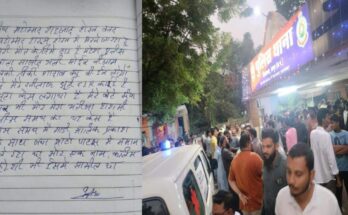Where- Follow the instructions of the National Green Authority.
Dhamtari, 18 November 2020. Under the instructions given by the National Green Authority (NGT), burning of crop residue (parali), para-stump in the district is banned with immediate effect. Collector Shri Jayaprakash Maurya has appealed to the farmers of the district not to burn stubble, para-stump etc. in their fields. He informed that along with the destruction of beneficial bacteria in the land by burning crop residue stub in the fields by farmers, air pollution from carbon dioxide, nitrous oxide, methane gas and a variety of toxic gases, worsening soil health and asthma in humans. , Lung disease and adverse effects on human health.
According to the provisions of the National Green Authority, if any farmer is found burning or burning crop residues in his fields, punitive or penalty action will be taken against him. Two and a half thousand rupees can be imposed on farmers holding two acres of agricultural land, five thousand rupees on farmers holding two to five acres of agricultural land and an environmental penalty of 15 thousand rupees per incident on farmers holding more than five acres of land. Instead of burning crop residues, suggestions are given to the farmers by the Department of Agriculture to manage them properly. Due to this, after harvesting, the crop residues are converted into compost by deep watering along with the residue lying in the field, From which the main and micro nutrients will be obtained for the next crop. After harvesting, after plowing the remaining residues in the field, turn it over in the field or collect it and put it in the pit or vermicompost stitches can be used for making compost.
Deputy Director Agriculture said that after sowing the crop residues on the field without burning, sowing with gerosididrin etc. for sowing, the moisture of the field as well as the crop residues lying above, also act as moisture conservation, so that weed control and The seeds will act as mulching for the correct germination. Crop residues can also be used for mushroom production. Organic elements obtained from the crop residues in the soil, which are converted into fertilizers in the soil, give the crops, thereby improving soil organization and structure as well as increasing the water holding capacity of the land. Waste can be saved by purchasing manure by preparing manure by rotten crop residues with waste decomposer fluid in the field itself. For example, by burning one ton of para, five kilograms of nitrogen on decomposing and composting, Preparing 12 kg of Sphur and five kg of Potash manure in the field prevents pest disease and weeds. At the same time crop cost can be reduced and yield can be increased and income can be increased. An incentive of Rs. 1000 / – per acre is provided to the farmers on crop residue management as per the prescribed criteria. Therefore, it has been appealed to the farmers to take advantage of the scheme by managing maximum number of crop residues. Farmers can contact their Regional Rural Agricultural Extension Officer / Senior Agricultural Development Officer office for information about the scheme. Grant money is provided. Therefore, it has been appealed to the farmers to take advantage of the scheme by managing maximum number of crop residues. Farmers can contact their Regional Rural Agricultural Extension Officer / Senior Agricultural Development Officer office for information about the scheme. Grant money is provided. Therefore, it has been appealed to the farmers to take advantage of the scheme by managing maximum number of crop residues. Farmers can contact their Regional Rural Agricultural Extension Officer / Senior Agricultural Development Officer office for information about the scheme.




